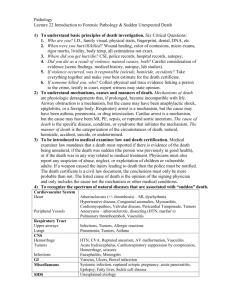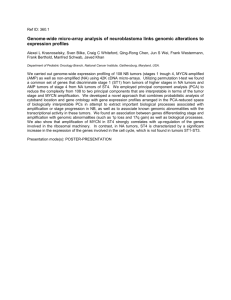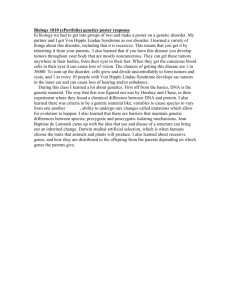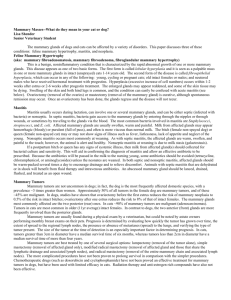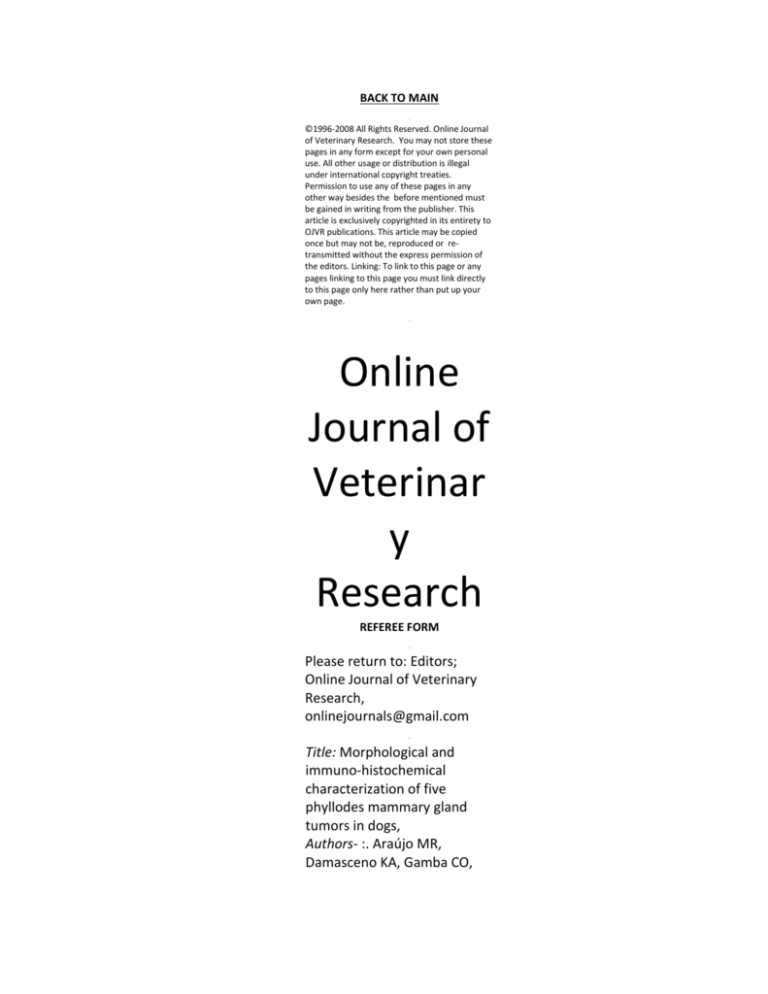
BACK TO MAIN
©1996-2008 All Rights Reserved. Online Journal
of Veterinary Research. You may not store these
pages in any form except for your own personal
use. All other usage or distribution is illegal
under international copyright treaties.
Permission to use any of these pages in any
other way besides the before mentioned must
be gained in writing from the publisher. This
article is exclusively copyrighted in its entirety to
OJVR publications. This article may be copied
once but may not be, reproduced or retransmitted without the express permission of
the editors. Linking: To link to this page or any
pages linking to this page you must link directly
to this page only here rather than put up your
own page.
Online
Journal of
Veterinar
y
Research
REFEREE FORM
Please return to: Editors;
Online Journal of Veterinary
Research,
onlinejournals@gmail.com
Title: Morphological and
immuno-histochemical
characterization of five
phyllodes mammary gland
tumors in dogs,
Authors- :. Araújo MR,
Damasceno KA, Gamba CO,
Campos CB, Campos LC, Reis
DC, Souza CM, Cassali GD.
Organization-ID: 296289-2014
The Editor must ensure that
the OJVR publishes only
papers which are scientifically
sound. To achieve this
objective, the referees are
requested to assist the Editor
by making an assessment of a
paper submitted for
publication by:
(a) Writing a report on the
reverse side of this form,
(b} Check the boxes shown
below under 1. and 2. ( YES or
NO) [N.B.A "NO" assessment
must be
supported by specific
comment in the report.
(c) Make a recommendation
under 3.
The Editor-in-Chief would
appreciate hearing from any
referee who feels that he/she
will be unable to review a
manuscript within two weeks.
1. CRITERIA FOR JUDGEMENT
(Mark "Yes" or "No").
Is the work
scientifically
sound? Y
Is the work an
original
contribution? Y
Are the conclusions justified
on the evidence presented? Y
Is the work free of major
errors in fact, logic or
technique? N see comments
Is the paper clearly and
concisely written? No see
changes
Do you consider that the data
provided on the care and use
of animals (See Instructions to
Contributors) is sufficient to
establish that the animals
used in the experiments were
well looked after, that care
was taken to avoid distress,
and that there was no
unethical use of animals? Yes
Ethics Statement?
2 PRESENTATION (Mark "Yes"
or "No").
Does the title
clearly indicate
the content of
the paper? Y
Does the
abstract convey
the essence of
the article? Y
Are all the
tables
essential? Y
Are the figures
and drawings of
good quality? Y
Are the
illustrations
necessary for
an
understanding
of the text? Y
Is the labelling
adequate? Y
3. RECOMMENDATIONS(Mark
one with an X)
Not suitable for
publication in
the OJVR
Reassess after
major changes
Accept for
publication
with minor
changes X
Accept for
publication
without
changes
4.REPORT., Comparison of dog
mammary tumors with similar
human tumors (as a model)
are widely available in the
literature. However, This
work of phyllodes mammary
gland tumors in dogs could
provide useful information for
similar tumors in women.
Epithelial and stromal tumor
cells cytokeratin AE1AE3,
Vimentin, Estrogen,
Progesterone receptor and
p63 data is especially relevant.
The percentage levels and
mortality data are probably of
very little practical use due to
limited sample size. TITLE:
Suggest shorten amore
descriptive to “Morphological
and immuno-histochemical
characterization of five
phyllodes mammary gland
tumors in dogs” ABSTRACT.
Some changes are needed for
readability (see attached).
INTRODUCTION: Relevant to
the work, well referenced and
concise. However there are
some grammatical errors (see
Attached Text).The use of
animal should simply be
replaced with Dog 1, 2 ect.
RESULTS (see text),
DISCUSSION (see attached).
Publish with these changes.
SUGGESTED ABSTRACT
In bitches, mammary tumors
represent 52% of all
neoplasms. The phyllodes
tumor is a rare fibro-epithelial
neoplasm found in humans
characterized by epithelial and
mesenchymal (stromal) cell
proliferation creating
elaborate leaf-like structures.
Morphological and immunehistochemical characteristics
in 5 canine phyllodes tumors
are described. Four benign
and one malignant phyllodes
tumors were diagnosed.
Epithelial and stromal tumor
cells were positive for
cytokeratin AE1AE3 and
vimentin, respectively, and all
were positive for estrogen and
progesterone receptors.
Benign tumors were negative
for p63 whereas the malignant
tumor was positive for p63.
Cell proliferation index was
<1% in benign tumors tissue
but 69.5% in the malignant
one. All tumors were negative
for c-KIT. The morphological
and immune-phenotypical
aspects observed in this study
suggest similarities between
phyllodes tumors diagnosed in
women and in bitches.
However, new studies are
necessary to enhance
knowledge regarding the
biological behavior of these
neoplasms.
CHANGES TO INTRODUCTION
In bitches, mammary
neoplasms represent 52% of
all diagnosed neoplasms of
which 50% are malignant.11
Many mammary tumors are
characterized by the
proliferation of epithelial,
myoepithelial, and
mesenchymal components
such as the mixed tumors,
frequently diagnosed in canine
mammary tumors.2
Neoplasms characterized by
an association of epithelial
and mesenchymal
(fibroepithelial) components,
such as the phyllodes tumor
(PT), are still rarely described
in the canine species.15 In
humans, PT represent a rare
histological subtype that is
histo-morphologicaly
characterized by an epithelial
and mesenchymal (stromal
component) cell proliferation
that, when associated, form
leaf-like structures.17
Clinically, PTs resemble
fibroadenomas but tend to
occur in older women.6 Most
PT behave in a benign fashion
with local recurrences
occurring in a small proportion
of cases. Very rarely the tumor
may metastasize mainly in
malignant grade cases.17
Ancillary diagnostic tools may
confirm the histogenesis and
help to identify tumors with
potentially aggressive
behavior, e.g.,
immunohistochemistry
assessment of vimentin, Ki-67
and c-KIT.3,13 On account of
insufficient data for the
occurrence and biological
behavior of canine mammary
gland PTs we describe clinicalpathological and immunehistochemical aspects of five
canine phyllodes tumors.
Changes to CASE REPORTS
(see Attached)
Chnages to RESULTS
(attached)
FIGURE 1 AND FIGURE 2
suggest separating to two
different figures
SUGGESTED CHANGES TO
MORTALITY DATA
Overall survival (OS) time in
days was defined as the period
between surgery and death
due to the tumor. Patient
follow-up was performed for
1018 days. Dog 1 was
diagnosed with a metastatic
solid carcinoma and treated
with adjuvant chemotherapy.
The treatment was aborted
before conclusion of 1018
days with the dog alive until
the last follow-up evaluation.
Dog 2 had radiographic images
of pulmonary metastasis and
was treated with adjuvant
chemotherapy but died due to
the tumor??(How do you
know this? with a OS of 374
days. Histopathological
analysis of distant metastasis
was not done. Dog 3 died one
day after excision of the
mammary gland lesion. Dog 4
had an OS of 513 days and
alive at the end of patient
follow-up. Animal 5 was
simultaneously diagnosed
with carcinomas in mixed
tumors and died 25 days
following the surgical
procedure, and cause of death
could not be determined.
SUGGESTED DISCUSSION (see
attached)





